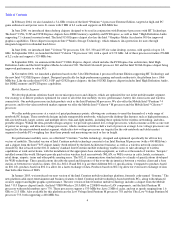Intel 2004 Annual Report Download - page 14
Download and view the complete annual report
Please find page 14 of the 2004 Intel annual report below. You can navigate through the pages in the report by either clicking on the pages listed below, or by using the keyword search tool below to find specific information within the annual report.
Table of Contents
Sales and Marketing
Most of our products are sold or licensed through sales offices located near major concentrations of users, throughout the Americas,
Europe, Asia-Pacific and Japan. Our business relies on continued sales growth in emerging markets and continued business and consumer
investment in technologies that use our products in mature markets.
Sales agreements typically contain standard terms and conditions covering matters such as pricing, payment terms and warranties, as well
as indemnities for issues specific to our products, such as patent and copyright indemnities. From time to time, we may enter into additional
agreements with customers covering, for example, changes from our standard terms and conditions, new product development and marketing,
private-label branding and other matters. Sales of particular products are generally conducted with purchase orders issued under the sales
agreements. Most of Intel’s sales are made using electronic and web-based processes that allow the customer to review inventory availability
and to track the progress of specific goods under order. Pricing on particular products may vary based on volumes ordered and other factors.
We sell our products to OEMs and ODMs. ODMs provide design and/or manufacturing services to branded and unbranded private-label
resellers. We also sell our products to industrial and retail distributors. In 2004, Dell Inc. accounted for approximately 19% of our total sales,
and Hewlett-Packard Company accounted for approximately 16% of our total sales. A substantial majority of the sales to these customers
consisted of products from our Intel Architecture business. No other customer accounted for more than 10% of our total revenue. For
information about revenue and operating profit by operating segments and revenue from unaffiliated customers by geographic region/country,
see “Note 19: Operating Segment and Geographic Information” in Part II, Item 8 of this Form 10-K and “Management’s Discussion and
Analysis of Financial Condition and Results of Operations” in Part II, Item 7 of this Form 10-K.
Typically, distributors handle a wide variety of products, including those that compete with our products, and fill orders for many
customers. Most of our sales to distributors are made under agreements allowing for price protection on unsold merchandise and a right of
return on stipulated quantities of unsold merchandise. We also utilize third-party sales representatives who generally do not offer directly
competitive products but may carry complementary items manufactured by others. Sales representatives do not maintain a product inventory;
instead, their customers place orders directly with us or through distributors.
Our worldwide reseller sales channel consists of thousands of indirect customers who are systems builders and purchase Intel
microprocessors and other products from our distributors. These systems builders receive various levels of technical and marketing services
and support directly from Intel. We have a “boxed processor program” that allows distributors to sell Intel microprocessors in small quantities
to these systems-builder customers; boxed processors are also made available in direct retail outlets.
Our global marketing strategy is designed to associate our brands with advanced technology and innovation. The Intel
®
brand is intended
to represent technology leadership, innovation, quality and reliability. Our product brands include Itanium, Intel Xeon, Pentium, Celeron and
Intel Centrino, which are all part of our ingredient brand family. We promote brand awareness and generate demand through our own direct
marketing as well as co-marketing programs. Our direct marketing activities include television, print and web-based advertising, as well as
press relations, consumer and trade events, and industry and consumer communications. Currently, our direct marketing to the consumer
focuses on the digital home and building awareness and demand for new usage models and capabilities. Our marketing directed toward
businesses focuses on our continuing to deliver technologies designed for performance and reliability to enterprise and small to midsize
businesses.
Purchases by customers often allow them to participate in cooperative advertising and marketing programs such as the Intel Inside
®
program. Through the Intel Inside program, certain customers are licensed to place Intel Inside logos on computers containing our
microprocessors and our other technology, and to use our brands in advertisements. The program includes a market development component
that accrues funds based on purchases and partially reimburses the OEMs for advertisements for products featuring the Intel Inside brand,
subject to the OEMs meeting defined criteria. This program broadens the reach of our brands beyond the scope of our own direct advertising.
Additionally, our reseller sales channel marketing programs are intended to extend the Intel Inside brand reach to channel customers and the
businesses and individuals that purchase computer systems from them.
Our products are typically shipped under terms that transfer title to the customer, even in arrangements for which the recognition of
revenue on the sale is deferred. The sales agreements typically provide that payment is due at a later date, generally 30 days after shipment,
delivery or the customer’s use of the product. Our credit department sets accounts receivable and shipping limits for individual customers for
the purpose of controlling credit risk to Intel arising from outstanding account balances. We assess credit risk through quantitative and
qualitative analysis, and from this analysis, we establish credit limits and determine whether we will seek to use one or more credit support
devices, such as obtaining some form of third-party guaranty or standby letter of credit, or obtaining credit insurance for all or a portion of the
account balance. Credit losses may still be incurred due to bankruptcy, fraud or other failure
11
























